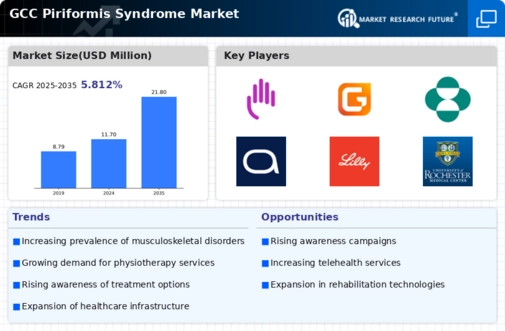The GCC Piriformis Syndrome Market has been witnessing a notable evolution driven by the increasing awareness of musculoskeletal disorders, alongside a growing emphasis on effective treatment regimens tailored to symptoms associated with Piriformis Syndrome. The competitive landscape is characterized by a blend of established pharmaceutical companies and emerging players, all vying to capture market share and offer innovative solutions for patients suffering from this condition. With healthcare systems in the GCC region steadily evolving, there is an urgent demand for comprehensive management options that address the complex nature of piriformis syndrome and its impact on quality of life.
Furthermore, collaborations and partnerships between stakeholders are anticipated to intensify, presenting opportunities to bring forth advanced therapies and patient-centric approaches.
Amgen has made a significant impact within the GCC Piriformis Syndrome Market, leveraging its strong research and development capabilities. The company is recognized for its extensive product portfolio that includes biologics developed to target pain and inflammation associated with musculoskeletal disorders. Amgen's commitment to innovation, coupled with a robust distribution network, allows it to effectively serve healthcare professionals and patients in the GCC. Its strengths lie in the ability to deliver well-tested and established therapies, along with a focus on educational initiatives aimed at improving the understanding of Piriformis Syndrome among healthcare practitioners.
The company's established relationships with key stakeholders in the GCC region enhance its market presence, allowing for tailored solutions that meet the specific needs of local patients.
Bristol-Myers Squibb's presence in the GCC Piriformis Syndrome Market is underscored by its dedication to advancing treatment solutions through a rich portfolio of therapeutic options. With key products focused on pain management and inflammatory responses, Bristol-Myers Squibb is well-positioned to address the nuances of piriformis syndrome in patients across the GCC. The company’s strengths include its robust clinical trials aimed at validating the efficacy of its drugs and fostering trust among healthcare providers and patients alike.
In recent years, Bristol-Myers Squibb has engaged in strategic mergers and acquisitions, expanding its reach and enhancing its capabilities within the musculoskeletal sector, ensuring that it remains competitive in the dynamic healthcare landscape of the region. The combination of its innovative pipeline and adapted strategies in response to local market conditions allows Bristol-Myers Squibb to sustain its growth trajectory in the GCC.
























